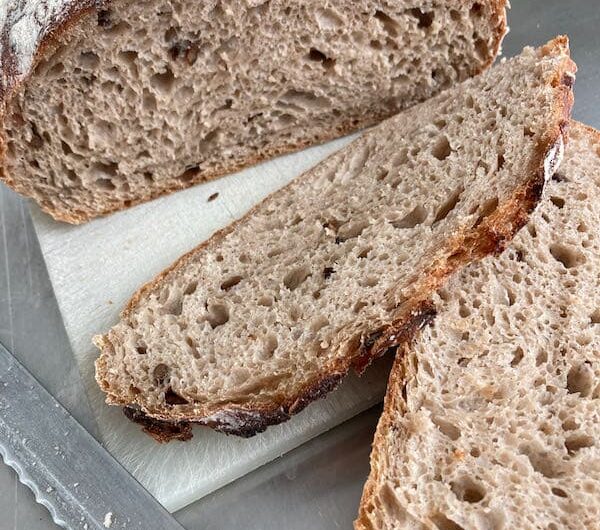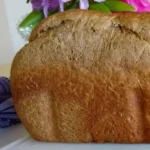You might be thinking, ‘Why should I bother making Barley Bread Recipe when I can easily buy regular bread from the store?’
Well, let me tell you, the health benefits of barley bread alone are worth the effort. Not only is barley bread packed with fiber and essential nutrients, but it also has a unique nutty flavor that will elevate your sandwich game to a whole new level.
So, if you’re ready to step up your bread game and improve your overall well-being, keep reading to discover the simple yet satisfying recipe for barley bread that will have you coming back for more.
Contents
- 1 Key Takeaways
- 2 Health Benefits of Barley Bread
- 3 Ingredients Needed for Barley Bread
- 4 Step-By-Step Instructions for Making Barley Bread
- 5 Tips for Achieving the Perfect Texture and Flavor
- 6 Barley Bread Recipe
- 7 Variations and Additions to Customize Your Barley Bread
- 8 Serving Suggestions and Storage Recommendations
- 9 Frequently Asked Questions
- 10 Conclusion-Barley Bread Recipe
Key Takeaways
- Barley bread is a healthy choice due to its rich fiber content, essential minerals, and low glycemic index.
- It offers various health benefits, including improved digestion, regulated blood sugar levels, strong bones, and a healthy immune system.
- Barley bread is packed with antioxidants that protect against chronic diseases and promote healthy skin.
- It can be easily incorporated into a nutritious diet and can be customized with different variations and additions for added flavor and texture.
Health Benefits of Barley Bread
Barley bread offers a multitude of health benefits that make it a nutritious and delicious choice for your daily diet. When compared to wheat bread, barley bread stands out in terms of its nutritional value.
Barley is rich in fiber, which aids in digestion and helps regulate blood sugar levels. It also contains essential minerals such as magnesium, selenium, and phosphorus, which are vital for maintaining strong bones and a healthy immune system.
One of the key advantages of barley bread over wheat bread is its low glycemic index. This means that it causes a slower rise in blood sugar levels, making it an excellent option for individuals with diabetes or those looking to manage their weight.
Moreover, barley bread is packed with antioxidants that protect your body against harmful free radicals and reduce the risk of chronic diseases like heart disease and cancer. These antioxidants are also known to support healthy skin and slow down the aging process.
With its impressive nutritional profile and numerous health benefits, barley bread is a smart choice for anyone seeking a wholesome and satisfying addition to their diet. So why not give this hearty and nutritious bread a try and experience the freedom of nourishing your body with the goodness of barley?
Ingredients Needed for Barley Bread
Now that you’re aware of the health benefits of barley bread, let’s dive into the essential ingredients needed to create this nutritious and delicious loaf.
Incorporating barley into your bread not only adds a unique flavor but also boosts its nutritional value. Here are the key ingredients you’ll need to make barley bread:
- Barley flour: The star ingredient of this recipe, barley flour is packed with essential nutrients like fiber, vitamins, and minerals. It provides a rich, nutty flavor to the bread and enhances its texture.
- Yeast: Yeast is responsible for the rising of the dough, giving the bread its light and airy texture. It works together with barley flour to create a fluffy and delicious loaf.
- Water: Water is the main liquid component in this recipe, helping to hydrate and activate the yeast. It also contributes to the overall structure and moistness of the bread.
Step-By-Step Instructions for Making Barley Bread
To start making your delicious and nutritious barley bread, begin by combining the dry ingredients in a large mixing bowl. In one column of a 2-column table, list the dry ingredients: barley flour, all-purpose flour, salt, and yeast. In the other column, provide the respective measurements: 2 cups of barley flour, 1 cup of all-purpose flour, 1 teaspoon of salt, and 2 teaspoons of yeast. Mix these dry ingredients together until they’re well combined.
Next, slowly add warm water to the dry ingredients while stirring continuously. Keep adding water until a soft and slightly sticky dough forms. Knead the dough on a floured surface for about 5-7 minutes, until it becomes smooth and elastic.
Place the dough in a greased bowl, cover it with a damp cloth, and let it rise in a warm place for about an hour, or until it doubles in size. Once the dough has risen, punch it down to release any air bubbles and shape it into a loaf.
Transfer the loaf to a greased bread pan and cover it with the damp cloth again. Let it rise for another 30-45 minutes. Meanwhile, preheat your oven to 375°F (190°C).
Bake the barley bread in the preheated oven for 30-35 minutes, or until it’s golden brown and sounds hollow when tapped on the bottom. Remove it from the oven and let it cool completely before slicing.
Troubleshooting tip: If your barley bread turns out too dense, try adding a bit more water to the dough or increasing the yeast amount. This will help the bread rise better and result in a lighter loaf.
Using barley flour in bread baking offers several benefits. Firstly, barley flour adds a nutty flavor and a pleasant aroma to your bread. It also enhances the overall texture, making it moist and chewy. Barley flour is also known for its high fiber content, which contributes to a healthier digestive system. Additionally, it contains important nutrients like iron, magnesium, and B vitamins, which are essential for good health.
Now that you have the step-by-step instructions and the knowledge of the benefits of using barley flour, you can confidently make your own delicious and nutritious barley bread. Enjoy the freedom to explore new flavors and nourish your body with this wholesome bread.
Tips for Achieving the Perfect Texture and Flavor
For a perfectly textured and flavorful barley bread, incorporate these expert tips into your baking process:
- Choose the right flour: Using the right type of barley flour is crucial for achieving the perfect texture and flavor. Look for finely ground barley flour, preferably made from hulled barley, as it will result in a lighter and more delicate bread.
- Add extra moisture: Barley flour tends to absorb more liquid than traditional wheat flour, so it’s important to increase the moisture content in your dough. Add an extra tablespoon or two of water or milk to prevent your bread from turning out dry.
- Avoid over-kneading: Unlike wheat flour, barley flour contains less gluten, which means over-kneading can lead to a dense and tough bread. Mix the dough until it comes together and then knead it gently until it becomes smooth and elastic.
To troubleshoot common mistakes and ensure the best results:
- If your bread turns out too dense, try increasing the amount of yeast or using bread flour in combination with barley flour.
- If the crust is too hard, bake the bread at a slightly lower temperature or cover it with aluminum foil halfway through baking to prevent excessive browning.
- For a more pronounced barley flavor, consider toasting the barley flour before incorporating it into your dough.
Barley Bread Recipe
Course: BakingCuisine: GlobalDifficulty: Moderate1
servings20
minutes45
minutes120
kcalBarley bread is a nutritious alternative to traditional wheat bread. Made with barley flour, it offers a hearty flavor and dense texture. This recipe provides step-by-step instructions to create a delicious loaf perfect for sandwiches or to accompany soups and stews.
Ingredients
2 cups barley flour
1 cup all-purpose flour
1 packet (2 1/4 tsp) active dry yeast
1 tsp salt
1 tbsp honey
1 cup warm water
2 tbsp olive oil
Directions
- In a large mixing bowl, combine barley flour, all-purpose flour, yeast, and salt.
- Add honey, warm water, and olive oil to the dry ingredients. Mix until a dough forms.
- Knead the dough on a floured surface for 8-10 minutes, or until it becomes smooth and elastic.
- Place the dough in a greased bowl, cover with a kitchen towel, and let it rise in a warm place for 1 hour, or until doubled in size.
- Punch down the risen dough and shape it into a loaf.
- Place the loaf on a baking sheet lined with parchment paper, cover with a towel, and let it rise for another 30 minutes.
- Preheat the oven to 375°F (190°C).
- Bake the bread for 40-45 minutes, or until it sounds hollow when tapped on the bottom.
- Let the bread cool on a wire rack before slicing and serving. Enjoy your homemade barley bread!
Variations and Additions to Customize Your Barley Bread
To add your own unique twist to your barley bread, explore the endless possibilities of variations and additions. By experimenting with different flavorful toppings, you can elevate the taste of your bread and make it truly your own. Consider adding ingredients like seeds, nuts, or dried fruits to add texture and enhance the flavor profile.
Sprinkling sesame seeds, chia seeds, or sunflower seeds on top of your bread before baking will create a deliciously crunchy crust. For a touch of sweetness, try adding chopped dried apricots, cranberries, or raisins. These additions won’t only make your barley bread more visually appealing but also add bursts of flavor with every bite.
If you’re looking for gluten-free alternatives, there are plenty of options available. You can replace the all-purpose flour with a gluten-free flour blend or use a combination of alternative flours like almond flour, rice flour, or quinoa flour. These alternatives will ensure that individuals with gluten sensitivities or dietary restrictions can also enjoy your homemade barley bread.
Serving Suggestions and Storage Recommendations
After customizing your barley bread with various toppings and additions, it’s time to explore the next aspect of enjoying your creation: serving suggestions and storage recommendations.
Here are some ideas to help you make the most of your delicious homemade barley bread:
- Toasted Delight: Slice the barley bread and toast it to perfection. Spread some creamy butter or your favorite jam on top for a delightful breakfast or snack option.
- Savory Sandwiches: Barley bread is sturdy enough to hold your favorite fillings. Layer it with fresh vegetables, deli meats, and cheeses to create a satisfying and wholesome sandwich.
- Bruschetta Bliss: Cut your barley bread into small slices and lightly toast them. Top with diced tomatoes, fresh basil, olive oil, and a sprinkle of salt for a flavorful bruschetta that will impress your guests.
When it comes to storing your barley bread, here are some helpful tips:
- Keep it Fresh: Store your barley bread in an airtight container or resealable bag to maintain its freshness. Alternatively, you can wrap it tightly in foil or plastic wrap.
- Freezing Option: If you have extra barley bread, freezing is a great way to extend its shelf life. Slice the bread before freezing and thaw individual slices as needed.
- Reheating: To enjoy your frozen barley bread, simply thaw it at room temperature or heat it in the oven for a few minutes to regain its warm and toasty texture.
With these serving suggestions and storage tips, you can make the most of your homemade barley bread and enjoy it whenever you desire freedom and a delicious meal.
Frequently Asked Questions
Can I Use a Bread Machine to Make Barley Bread?
Yes, you can use a bread machine to make barley bread. It offers the benefits of convenience and ease. However, using traditional baking techniques allows for a more hands-on and authentic experience. It’s up to you to decide which method suits your preference.
How Long Does Barley Bread Stay Fresh?
Barley bread typically stays fresh for about 3-5 days. To maintain its freshness, store it in a cool, dry place in an airtight container. Enjoy the delicious taste and long shelf life of barley bread!
Can I Substitute Barley Flour With Another Type of Flour?
Yes, you can substitute barley flour with other types of flour like wheat, rye, or spelt. Each flour will lend a unique taste and texture to your bread, so experiment to find your favorite!
Can I Freeze Barley Bread for Later Use?
Yes, you can freeze barley bread for later use. Freezing techniques preserve its freshness and extend its shelf life. The benefits of using barley flour include added nutrients and a unique flavor. Enjoy the freedom of having homemade bread whenever you want!
Is Barley Bread Suitable for People With Gluten Intolerance?
If you have gluten intolerance, barley bread may not be suitable for you. However, there are alternatives to barley flour for gluten-free baking, and incorporating barley into a gluten-free diet can have several benefits.
Conclusion-Barley Bread Recipe
In the golden crust of homemade barley bread lies a world of health benefits and delicious flavor. With its high fiber content and ability to lower cholesterol, this bread is a true champion of nutrition.
Follow the simple steps and add your own personal touch to create a loaf that will tantalize your taste buds and nourish your body.
So go ahead, slice into this wholesome creation and savor the goodness that barley bread brings to your table.





